 1) What the fuck is going on?
1) What the fuck is going on?
So much is going on that it’s hard to know where to begin. ArtHouse Cabaret just closed and in three days we’ve turned around the space to put up Hysteria, Canada’s largest multi-disciplinary festival of women’s work. Our Queer Youth Program is going gangbusters. And we’re reading Rhubarb submissions. And I just got back from two weeks in Japan. (Oh, and my whole house needs a general clean . . .)
2) How have you developed as an Artistic Director since first joining Buddies in Bad Times Theatre in 1999?
I came to Buddies as pretty much a neophyte, having run only one company before, and that (Cahoots Theatre Projects) was a much smaller organization and only for two years. So the learning curve has been tremendous since I got here. The company itself has grown and shifted, most notably from our focus on script and play development towards supporting the creation and presentation of more form-based theatre. My development continues as I work to catch up my training with the current trends in theatre, away from scene- and character-driven drama, and more towards a looser depiction of what theatre and theatre creation might be.
3) Are there any overarching themes or ideas that are common to the work being presented in Buddies’ current season?
I think there are themes of interactivity and interfacing that pervade works like Gay4Pay, Art Fag and The Beauty Salon, and notions of playfulness that permeate all of the work that Buddies is producing within the season. We jokingly called it our “playful, play-less” season. We’re forcing the audience to re-evaluate how they perceive theatre, and we want to make it an enjoyable experience.
4) Do you ever feel restricted by Buddies’ mandate of promoting queer Canadian culture?
We have turned what some might perceive as a restricting label into something much more liberating by approaching the term queer as two-pronged. As such, we’re pursuing work which is queer in an LGBT sense, but also queer as in work of challenge, which counters mainstream habits and conceptions.
 5) How well are queer Canadians being served by and represented in contemporary Canadian theatre?
5) How well are queer Canadians being served by and represented in contemporary Canadian theatre?
I think LGBT Canadians have a fair amount of representation in contemporary Canadian theatre. Most mainstream theatre companies will include at least one show within their season that features an LGBT character or theme. Many LGBT playwrights are being produced by major companies. That being said, I think a lot of LGBT work gets “whitewashed” as it goes through a process of dramaturgy, direction and presentation in the hands of non-LGBT artists. Queer work, on the other hand – alternative work that challenges the norm – is often still marginalized by the larger companies, often out of a fear of disturbing their crucial subscriber base.
6) What qualities do you look for when committing to the development of an emerging artist?
For me personally, I look for someone who has something different to say and can articulate what it is they are striving towards. I look for someone who is at a point where interactions with other artists or with dramaturgy or direction are welcome and not struggled with. And finally I look for originality in ideas, in voice, and in presentation.
7) At the independent theatre level, what should members of a theatre company expect from an Artistic Director?
If you are referring to members of a theatre company and their own AD it is difficult for me to answer since Buddies is not an ensemble company. We bring creative members on in a show-by-show basis. If you are referring to the broader sense of what should independent theatre artists expect from the AD of a company like Buddies, I think they should expect to be seen, and listened to. Their ideas heard, if not acted upon. And I think they should expect an element of leadership in that theatre’s involvement in the community. But they should also expect that each company has a focus that is more specific than the breadth of their mandate, and although their idea may fit the mandate, they should expect that it does not always fit the company. (I’m not sure I got that one right . . .)
 8) What can theatre makers learn from cabaret that they might not get from other forms of theatre?
8) What can theatre makers learn from cabaret that they might not get from other forms of theatre?
I think one of the great things about cabaret is the versatility that can be presented within a single program. How often do we go to the theatre for an exciting evening, only to be disappointed by the same “flavour” all the way through? I also think one of the great advantages of cabaret is the ability to more easily extract what doesn’t fit or doesn’t work. Wouldn’t it be great to be able to simply lift out that scene or that character that just doesn’t work in a drama?
9) If you could change one thing about theatre in Toronto, what would it be?
I think I would want to shake up the audiences. And the theatres for that matter. To both be more challenging of each other.
10) What is ArtSexy?
ArtSexy is an attitude. It’s a state of mind. It’s a sexy new website for Buddies in Bad Times Theatre.
The most amazing thing to me about Buddies is the demographic of its audience. When I go see a show there, i am surrounded by people who are on average 20 years younger than any other theatre in Toronto that produces a regular season. I can think of other indie companies hat pull this off for their indiividual shows, but nowhere else that accomplishes it with a subscription season. It lends hope….
“. . . I look for someone who has something different to say and can articulate what it is they are striving towards. I look for someone who is at a point where interactions with other artists or with dramaturgy or direction are welcome and not struggled with. And finally I look for originality in ideas, in voice, and in presentation.”
I wish I had read this 10 years ago – and listened.
Back then, I fancied myself a bit of a painter and brought some work in to Buddies to see if they’d be interested in showing it. This was a few years before Oiye joined the company as AD. Anyway – and my memory for names is failing me now – the woman I showed them to said the work was “not cohesive.” Which was true. The work was not cohesive. It stung at the time, but it was actually pretty good feedback.
I think David articulates a similar sentiment here: aside from the passion and the technique and the whathaveyou, an emerging artist needs to have a sense of what it is they are trying to say, and be able to articulate that to their peers, and in collaboration with their peers – particularly when it comes to theatre.
Anyway – David’s awesome response to that question about emerging artists reminded me of that story.
Congratulations to Buddies!
It’s great when something that is called all-inclusive is really all-inclusive. No matter age, gender or artform. It’s wonderful
Meredith
Buddies continues to walk the cutting edge and ask the questions of both audience and artists that are vital to the health of this community. It is definetly a model and a source of inspiration for indie theatre artists trying to create new and challenging theatre and having an audience who wants to see it.
Hats off to David Oiye!
To Ian’s point,
This is the great challenge to the Theatre Artist: To be able to articulate the urgency and passions of one’s artistic vision, while having the humilty to take the critcism of your peers constructively. To realize that your ideas are bigger than you!
Awful creature.